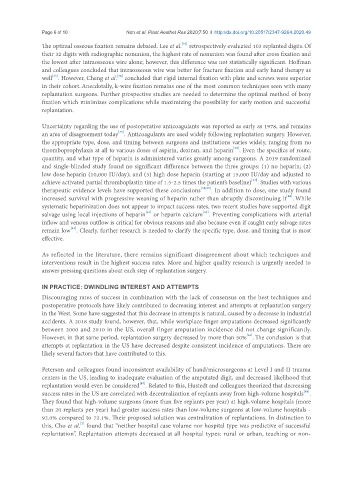Page 580 - Read Online
P. 580
Page 6 of 10 Noh et al. Plast Aesthet Res 2020;7:50 I http://dx.doi.org/10.20517/2347-9264.2020.49
[32]
The optimal osseous fixation remains debated. Lee et al. retrospectively evaluated 103 replanted digits.Of
their 32 digits with radiographic nonunion, the highest rate of nonunion was found after cross fixation and
the lowest after intraosseous wire alone; however, this difference was not statistically significant. Hoffman
and colleagues concluded that intraosseous wire was better for fracture fixation and early hand therapy as
[33]
[34]
well . However, Cheng et al. concluded that rigid internal fixation with plate and screws were superior
in their cohort.Anecdotally, k-wire fixation remains one of the most common techniques seen with many
replantation surgeons. Further prospective studies are needed to determine the optimal method of bony
fixation which minimizes complications while maximizing the possibility for early motion and successful
replantation.
Uncertainty regarding the use of postoperative anticoagulants was reported as early as 1978, and remains
an area of disagreement today . Anticoagulants are used widely following replantation surgery. However,
[35]
the appropriate type, dose, and timing between surgeons and institutions varies widely, ranging from no
[36]
thromboprophylaxis at all to various doses of aspirin, dextran, and heparin . Even the specifics of route,
quantity, and what type of heparin is administered varies greatly among surgeons. A 2019 randomized
and single-blinded study found no significant difference between the three groups: (1) no heparin; (2)
low dose heparin (10,000 IU/day); and (3) high dose heparin (starting at 15,000 IU/day and adjusted to
[37]
achieve activated partial thromboplastin time of 1.5-2.5 times the patient’s baseline) . Studies with various
therapeutic evidence levels have supported these conclusions [38,39] . In addition to dose, one study found
increased survival with progressive weaning of heparin rather than abruptly discontinuing it . While
[40]
systematic heparinization does not appear to impact success rates, two recent studies have supported digit
[42]
salvage using local injections of heparin or heparin calcium . Preventing complications with arterial
[41]
inflow and venous outflow is critical for obvious reasons and also because even if caught early salvage rates
[43]
remain low . Clearly, further research is needed to clarify the specific type, dose, and timing that is most
effective.
As reflected in the literature, there remains significant disagreement about which techniques and
interventions result in the highest success rates. More and higher quality research is urgently needed to
answer pressing questions about each step of replantation surgery.
IN PRACTICE: DWINDLING INTEREST AND ATTEMPTS
Discouraging rates of success in combination with the lack of consensus on the best techniques and
postoperative protocols have likely contributed to decreasing interest and attempts at replantation surgery
in the West. Some have suggested that this decrease in attempts is natural, caused by a decrease in industrial
accidents. A 2018 study found, however, that, while workplace finger amputations decreased significantly
between 2000 and 2010 in the US, overall finger amputation incidence did not change significantly.
However, in that same period, replantation surgery decreased by more than 50% .The conclusion is that
[44]
attempts at replantation in the US have decreased despite consistent incidence of amputations. There are
likely several factors that have contributed to this.
Peterson and colleagues found inconsistent availability of hand/microsurgeons at Level I and II trauma
centers in the US, leading to inadequate evaluation of the amputated digit, and decreased likelihood that
replantation would even be considered . Related to this, Hustedt and colleagues theorized that decreasing
[45]
[46]
success rates in the US are correlated with decentralization of replants away from high-volume hospitals .
They found that high-volume surgeons (more than five replants per year) at high-volume hospitals (more
than 20 replants per year) had greater success rates than low-volume surgeons at low-volume hospitals -
92.0% compared to 72.1%. Their proposed solution was centralization of replantations. In distinction to
[2]
this, Cho et al. found that “neither hospital case volume nor hospital type was predictive of successful
replantation”. Replantation attempts decreased at all hospital types: rural or urban, teaching or non-

